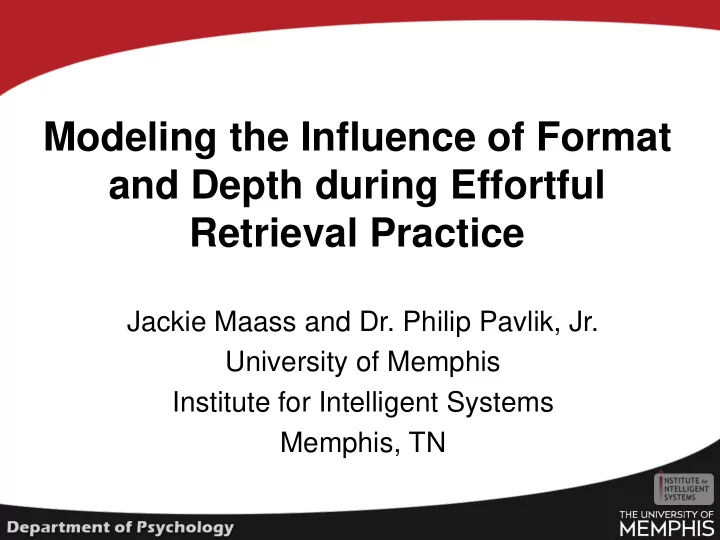

Modeling the Influence of Format and Depth during Effortful Retrieval Practice Jackie Maass and Dr. Philip Pavlik, Jr. University of Memphis Institute for Intelligent Systems Memphis, TN
What’s to Come • Background on the Testing Effect • The Current Work – Research Questions – Experimental Design – Results • Modeling Retrieval Practice Performance – Implications
Introducing… • Testing Effect – Consistent benefit of quizzing oneself as a method of practice over re-reading or re-studying information (e.g., Roediger III & Karpicke, 2006; Thompson, Wegner, & Bartling, 1978) • Practical Issues for Implementation in Education – Ease of administration, item difficulty • Question Depth and Answer Format
Answer Format • Benefit of practice tests with less retrieval cues • Most beneficial formats: Free Recall > Cued Recall > Recognition Essay Questions > Short Answer > Multiple Choice or (e.g., Glover, 1989; Kang, McDermott, & Roediger III, 2007; McDaniel, et. al., 2007)
Why are less cues better? • Retrieval effort hypothesis (Pyc & Rawson, 2009) – There is more memorial benefit from successful retrieval practice when it is difficult than when it is less difficult – Motivated by: • Bjork’s (1994, 1999) desirable difficulty framework • Craik and Lockhart’s (1972) depth of processing research
Research Questions Further investigating the effect of effortful retrieval practice • Can we increase the difficulty of items through either format (multiple choice vs. short answer) and/or through depth (factual vs. applied)? • Does retrieval need to be successful in order to be beneficial? • Do participants benefit from more difficult items? – If so, is the cause of the increase in difficulty an important factor (i.e., depth or format)?
My Design 2 (retrieval format: MC, SA) Between-subjects Fully-factorial x 2 (retrieval depth: factual, applied) x 2 (posttest format: MC, SA) Within-subjects x 2 (posttest depth: factual, applied) MC= Multiple Choice SA= Short Answer
Materials Factual Applied Text Which Why doesn't oxygen The heart is a pump. Its component of the rich blood flow walls are made of thick circulatory directly from the muscle. They can squeeze system acts as a lungs to the rest of the (contract) to send blood pump? body? rushing out. [...] The oxygen-rich blood is returned to the left atrium of the heart and pumped out to the body through the left ventricle.
Procedure Retrieval Practice Posttest Read text Pretest Between-subjects Within-subjects 2 (Depth: Applied, Factual) 2 (Depth: Applied, Factual) Factual questions x 2 (Format: SA, MC) x 2 (Format: SA, MC) Half in SA, half in MC 8 questions 8 questions 8 repeated, 8 new questions No repetitions Repeated 4x each No repetitions 8 trials total 32 trials total 16 trials total No Feedback Feedback No feedback
Procedure Retrieval Practice Posttest Pretest Read text Between-subjects Within-subjects 6 emotions: frustration, anxiety, confusion, discouraged, bored, distracted
Results • Participants – N = 178 after 15 were removed • (5 glitches, 10 had 10+ timeouts) – Amazon Mechanical Turk; $5; 1 hour – Native English Speaker/ US or Canada – “Reliable” Mturk worker
Modeling Retrieval Practice • Logistic mixed-effects regression to model performance during the retrieval practice phase • Based on a Performance Factors Analysis (Pavlik, Cen, & Koediger, 2009) – differentiates prior incorrect and correct trials. Participant Performance during Practice 1.0 Proportion Correct .8 .6 .4 .2 3 4 1 2 Trial
Process of Modeling • 2 parameters to capture the count of prior correct and incorrect trials • Pretest score and a random effect of participant • Variables to capture format, depth, time on task, affect, and interactions of these factors with the (in)correctness of previous trials • Final Model= 9 parameters, R 2 = .359
Summary of Fixed Effects for Logistic Regression Model Predicting Future Success log of (1 + the prior count) MC = 0 SA = 1 Factual = 0 Applied = 1 Average of confusion before & after practice
Summary of Fixed Effects for Logistic Regression Model Predicting Future Success More gained from a successful over unsuccessful trials Negative parameter value for the more difficult format and/or depth More gained from successes on trials of the more difficult format and/or depth Coding: MC=0, SA=1; Factual=0; Applied=1
Cross-Validation • Ten runs of a 10-fold cross-validation – Training R 2 = .293 – Testing R 2 = .284 • 96.8% of the validity of the model was retained in the held out data Predicted Performance Actual Performance 1.0 1.0 Proportion Correct .8 .8 .6 .6 .4 .4 .2 .2 3 4 1 2 Trial 3 4 1 2
Revisiting our Questions • Can we increase the difficulty of items through either format (multiple choice vs. short answer) and/or through depth (factual vs. applied)? • Does retrieval need to be successful in order to be beneficial? successful retrieval of • Do participants benefit from more difficult items? – If so, is the cause of the increase in difficulty an important factor (i.e., depth or format)?
Implications • Scheduling practice based on our results – Early on, use multiple choice to increase chance of success or factual – Transition into short answer to get the most out of or applied practice
Thank you! Any Questions Website: https://sites.google.com/site/jaclynmaass Email: Jaclyn.maass@gmail.com
Recommend
More recommend